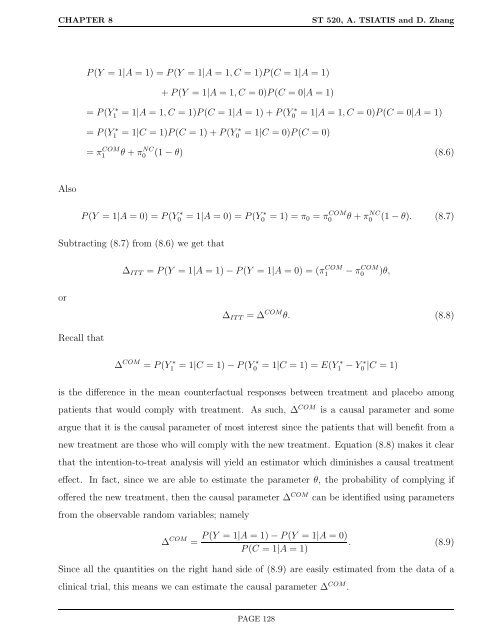ST 520 Statistical Principles of Clinical Trials - NCSU Statistics ...
ST 520 Statistical Principles of Clinical Trials - NCSU Statistics ...
ST 520 Statistical Principles of Clinical Trials - NCSU Statistics ...
Create successful ePaper yourself
Turn your PDF publications into a flip-book with our unique Google optimized e-Paper software.
CHAPTER 8 <strong>ST</strong> <strong>520</strong>, A. TSIATIS and D. Zhang<br />
Also<br />
P(Y = 1|A = 1) = P(Y = 1|A = 1, C = 1)P(C = 1|A = 1)<br />
= P(Y ∗<br />
1<br />
= P(Y ∗<br />
1<br />
+ P(Y = 1|A = 1, C = 0)P(C = 0|A = 1)<br />
= 1|A = 1, C = 1)P(C = 1|A = 1) + P(Y ∗<br />
0<br />
= 1|C = 1)P(C = 1) + P(Y ∗<br />
0<br />
= 1|C = 0)P(C = 0)<br />
= 1|A = 1, C = 0)P(C = 0|A = 1)<br />
= π COM<br />
1 θ + π NC<br />
0 (1 − θ) (8.6)<br />
P(Y = 1|A = 0) = P(Y ∗<br />
0<br />
Subtracting (8.7) from (8.6) we get that<br />
or<br />
Recall that<br />
= 1|A = 0) = P(Y ∗<br />
∆ITT = P(Y = 1|A = 1) − P(Y = 1|A = 0) = (π COM<br />
1<br />
∆ COM = P(Y ∗<br />
1<br />
= 1|C = 1) − P(Y ∗<br />
0<br />
0 = 1) = π0 = π COM<br />
0 θ + π NC<br />
0 (1 − θ). (8.7)<br />
− π COM<br />
0 )θ,<br />
∆ITT = ∆ COM θ. (8.8)<br />
= 1|C = 1) = E(Y ∗<br />
1<br />
∗<br />
− Y0 |C = 1)<br />
is the difference in the mean counterfactual responses between treatment and placebo among<br />
patients that would comply with treatment. As such, ∆ COM is a causal parameter and some<br />
argue that it is the causal parameter <strong>of</strong> most interest since the patients that will benefit from a<br />
new treatment are those who will comply with the new treatment. Equation (8.8) makes it clear<br />
that the intention-to-treat analysis will yield an estimator which diminishes a causal treatment<br />
effect. In fact, since we are able to estimate the parameter θ, the probability <strong>of</strong> complying if<br />
<strong>of</strong>fered the new treatment, then the causal parameter ∆ COM can be identified using parameters<br />
from the observable random variables; namely<br />
∆ COM =<br />
P(Y = 1|A = 1) − P(Y = 1|A = 0)<br />
. (8.9)<br />
P(C = 1|A = 1)<br />
Since all the quantities on the right hand side <strong>of</strong> (8.9) are easily estimated from the data <strong>of</strong> a<br />
clinical trial, this means we can estimate the causal parameter ∆ COM .<br />
PAGE 128
















